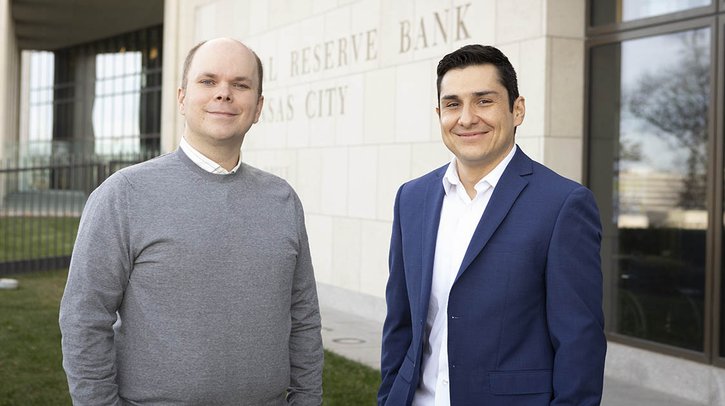In January 2021, congressional legislation was proposed to increase the national minimum wage from $7.25 per hour—where it had stood for more than 10 years—to $15 per hour. At the time, the federal funds rate—the target interest rate at which banks borrow and lend to each other overnight—had been near zero since March 2020, when the Federal Open Market Committee (FOMC) sharply cut the rate in response to the COVID-19 shock.
In their September 2021 Economic Review article, Senior Economist Andrew Glover and Research and Policy Officer José Mustre-del-Río examined how monetary policy might amplify or dampen the response of employment and inflation to an increase in the minimum wage.

Senior Economist Andrew Glover (left) and Research and Policy Officer José Mustre-del-Río
Why is it important to understand the relationship between monetary policy decisions and minimum wage changes?
Real interest rates are a key determinant of household spending, and these depend on nominal interest rates and inflation. If a minimum wage increase leads to a rise in aggregate prices, and the Federal Reserve raises nominal interest rates more than one-for-one with increases in inflation, then the real interest rate effectively rises in response to an increase in the minimum wage. Because higher real interest rates make saving more attractive than spending, aggregate demand might fall. Thus, the minimum wage increase might ultimately have a negative effect on employment and spending. However, if the central bank instead keeps nominal rates constant, or raises them less than one-for-one with increases in inflation, then the real interest rate will decline and spending will become more attractive than saving, which can boost aggregate demand. In this case, the minimum wage could have a positive effect on employment and spending.
How might low-wage and high-wage workers be affected?
According to our quantitative analysis, low-wage workers benefit regardless of the central bank’s actions, but for different reasons. If the central bank keeps rates fixed, they benefit both from a higher hourly rate, but also because of greater demand for their labor due to higher demand for the goods and services they produce. If the central bank raises rates to bring down inflation, then low-wage workers only benefit from a higher hourly wage rate as demand for their labor falls. In contrast, high-wage workers only benefit from a higher minimum wage when the central bank keeps rates fixed. They only benefit from higher demand (brought by the fixed nominal rate) as their hourly wage rate does not change.
What are some of your conclusions from the study?
In our analysis, an increase in the minimum wage is more expansionary when the central bank has a higher tolerance for inflation.
Indeed, even though only a modest fraction of workers actually earns the minimum wage, our quantitative analysis reveals a mechanism by which a minimum wage increase actually could lead to increased output, provided that inflation is allowed to rise.
